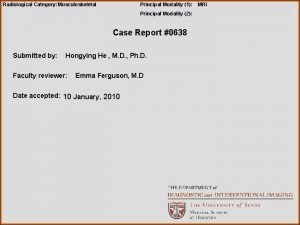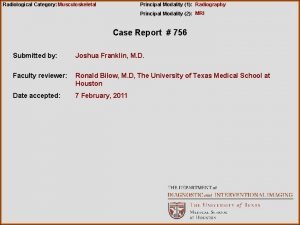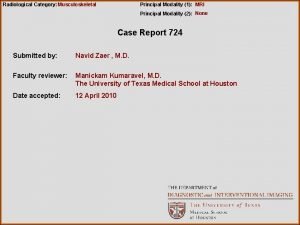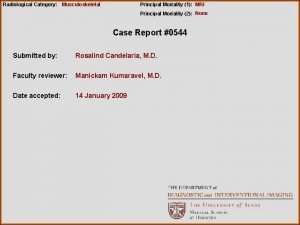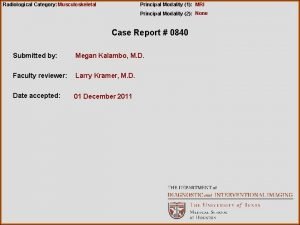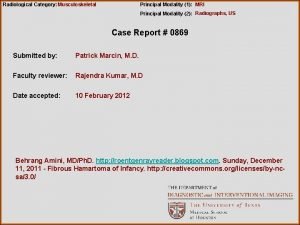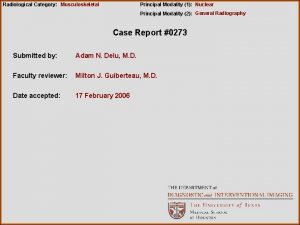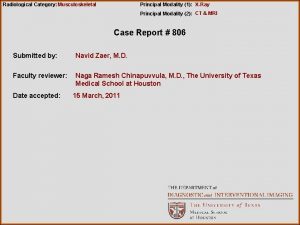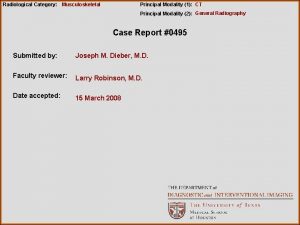Radiological Category Musculoskeletal Principal Modality 1 CTMRI Principal












- Slides: 12

Radiological Category: Musculoskeletal Principal Modality (1): CT/MRI Principal Modality (2): General Radiography Case Report #0569 Submitted by: Hongying He , M. D. , Ph. D. Faculty reviewer: John Madewell, M. D. Date accepted: 10 February 2009

Case History 38 -year-old woman with no significant past medical history presented with left hip pain and stiffness.

Radiological Presentations

Radiological Presentations

Radiological Presentations

Radiological Presentations

Radiological Presentations

Test Your Diagnosis Which one of the following is your choice for the appropriate diagnosis? After your selection, go to next page. • Synovial osteochondromatosis • Pigmented villonodular synovitis • Amyloidosis • Pseudotumor of hemophilia • Osteochondritis dissecans • Avascular necrosis • Chronic joint infection e. g. TB

Findings and Differentials Findings: AP radiograph of the left hip demonstrates pressure erosions of the femoral neck, the central portion of the acetabulum and the fovea centralis of the femoral head. Extensive calcification around the hip joint is also seen. CT demonstrates erosions of the femoral head and acetabulum and numerous calcified bodies of similar size in the hip joint and extensive synovial dissecting pouches surrounding the joint. Some calcification has “ring-and-arc” configuration. MRI showes diffuse synovial process of low signal intensity on T 1, high signal intensity on. T 2 and contrast enhancement. Lower signal intensity regions on T 2 and T 1 post contrast images are present. Extension to the surrounding bursa and soft tissue is also seen. Differentials: • The imaging findings are virtually pathognomonic for synovial osteochondromatosis.

Discussion Synovial osteochondromatosis represents an uncommon benign neoplastic process with hyaline cartilage nodules in the subsynovial tissue of a joint, tendon sheath, or bursa. The nodules may enlarge and detach from the synovium. The knee, followed by the hip, in male adults are the most commonly involved sites and patient population. Radiologic findings are frequently pathognomonic. Radiographs reveal multiple intraarticular calcifications (70%– 95% of cases) of similar size and shape, distributed throughout the joint, with typical "ring-and-arc" chondroid mineralization. Extrinsic erosion of bone is seen in 20%– 50% of cases. Computed tomography (CT) optimally depicts the calcified intraarticular fragments and extrinsic bone erosion. Magnetic resonance (MR) imaging findings are more variable, depending on the degree of mineralization, although the most common pattern (77% of cases) reveals low to intermediate signal intensity with T 1 weighting and very high signal intensity with T 2 -weighting with hypointense calcifications. These signal intensity characteristics on MR images and low attenuation of the nonmineralized regions on CT scans reflect the high water content of the cartilaginous lesions. CT and MR imaging depict the extent of the synovial disease (particularly surrounding soft-tissue involvement) and lobular growth. Treatment is surgical synovectomy with removal of chondral fragments; recurrence rates range from 3% to 23%. Malignant transformation to chondrosarcoma is unusual (5% of cases) and, although difficult to distinguish from benign disease, is suggested by multiple recurrences and marrow invasion. Recognizing the appearances of synovial osteochondromatosis, which reflect their underlying pathologic characteristics, improves radiologic assessment and is important to optimize patient management.

Diagnosis Synovial osteochondromatois (Surgically confirmed)

Reference Manaster BJ, May DA & Disler DG. The Requisites: Musculoskeletal Imaging. 3 rd ed. Philadelphia, PA: Mosby Elsevier, 2007 Murphey MD etal. From the Archives of the AFIP. Imaging of Synovial Chondromatosis with Radiologic-Pathologic Correlation. Radio. Graphics 2007; 27: 1465 -1488
 Erate pa
Erate pa Tennessee division of radiological health
Tennessee division of radiological health Center for devices and radiological health
Center for devices and radiological health National radiological emergency preparedness conference
National radiological emergency preparedness conference Radiological dispersal device
Radiological dispersal device Entity class in software engineering
Entity class in software engineering Cardinality and modality
Cardinality and modality Deontic and epistemic modality exercises
Deontic and epistemic modality exercises Cardinality and modality
Cardinality and modality Cardinality and modality in database
Cardinality and modality in database Imaging modality
Imaging modality Pacs modality workstation
Pacs modality workstation Stefan savi
Stefan savi













